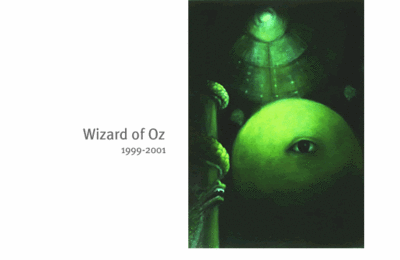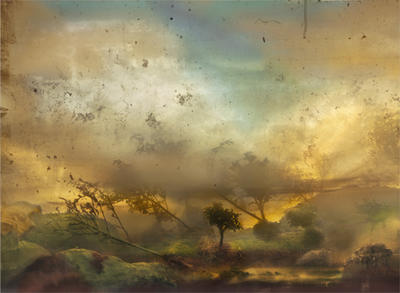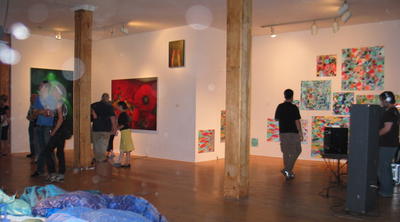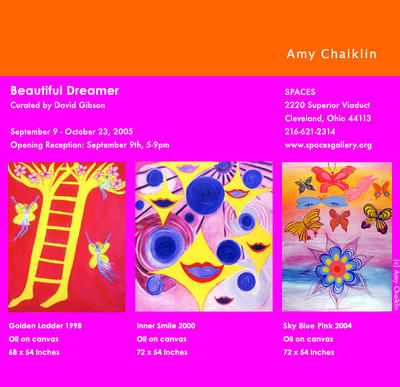 SOME BEAUTIFUL DREAMERS, Clockwise from center: David Gibson, Mary Ann Strandell, Ruth Waldman, Drew Shiflett, Tara Giannini, Mark Power, Karen Marston, Leemour Pelli, and Conrad Vogel
SOME BEAUTIFUL DREAMERS, Clockwise from center: David Gibson, Mary Ann Strandell, Ruth Waldman, Drew Shiflett, Tara Giannini, Mark Power, Karen Marston, Leemour Pelli, and Conrad Vogel Elizabeth Huey: The Cyclothmic Forest, 2005, Courtesy Feigen Contemporary, New York
Elizabeth Huey: The Cyclothmic Forest, 2005, Courtesy Feigen Contemporary, New YorkCatalogue essay accompanying the exhibition "Beautiful Dreamer" at SPACES, 2220 Superior Viaduct, Cleveland, Ohio, September 9 to October 23, 2005
The purpose of Beautiful Dreamer is to discover the inherent truths contained in art work that explores the fantastic, the ambiguous, the obscure, and the fanciful in order to gain perspective on agendas of contemporary art production and the contingencies of meaning which they share. This exhibition explores the context of romanticism in the situation of contemporary art, its roots in certain historical tendencies, its cultivation of a genre of inspiration, and the resulting variety of forms which emerge from it. A nearly paradigmatic sensibility serves not only as the means for creative expression in the arts, but also as the basis for revolutions in scientific, social, or political change. The "beautiful dreamer" of the title is both an archetype and a person, directed by a divine wish to connect with the inspirational elements in both conscious and unconscious endeavor that feed our dreams, and alternately, our ability to dream.



An interest in the fanciful and the fantastic leads into areas of introspection and wild conjecture that cultivate our desire to escape from the demands of quotidian existence. The artist creates a version of the world that can be laid over the real world, deceptively replacing it with a version which incorporates genres of ambiguity and agendas of aesthetic inquiry which both critique and subvert reality itself. These two terms--the fanciful and the fantastic--illustrate a variety of forms and expressions available to us in the realm of the unconscious where dreams and reveries first occur. Our memory of dreams, and the texture of that sort of experience, inspires us to reflect upon our conscious endeavor. The fanciful can best be described as that order which compares to an experience of beauty, of its tendency to charm and compel us, and is realized in scenes where a romantic sensibility finds its most facile, nearly kitsch interest (i.e. scenes from a bygone past, ranging from Medieval to Victorian models) which encourages a form of escapism from the mundane that finds its best response in a fulfillment of such ends. The fantastic, on the other hand, refers to a forward-looking worldview, in which vistas of unknown character and dimension are sought out, and all that holds them together is the moral aspect with which we conduct ourselves. This genre of inspiration is best illustrated in terms of science fiction and the metaphysical continuum which radically intertwines in this specific context with the quality of adventurous experience that it makes possible.


The ambiguous and the obscure also contribute heavily to our understanding of the nature of inspiration, yet in fairly oblique ways. Their immediate effect is one of being overwhelmed by mystery, or by the details, whether the forms communicating them emerge from the unconscious, as in the paintings of Salvador Dali, or travel to us from faraway lands, as in the exotic influences of Asian or Middle-Eastern palaces and landscapes. The artists I have chosen for this exhibition all express a rigor of reverie-a formal focus combined with and constrained by an intensity of vision which is unencumbered by ulterior agendas whether they be personal, political, or unconscious.


Themes and agendas consistent to the many bodies of work comprising this exhibition include: an engagement with the unknown; the imposition of aesthetic absolutes; the dramatization of psychological landscapes; and building a visual context to the collective unconscious. Such themes are both process and product, and alternately they contribute to the same source from which they draw their initial energies. The overall agenda of romanticism holds sway in each case, emboldened by the separate goals which independent artists provide for its envisioning. In order to better comprehend the utility of each of these themes, one can view the artists participating in Beautiful Dreamer as active practitioners in expanding the influence of romanticism, though it may radically depart from its original meaning in art history.
Use of the body as a means of experiencing the realm of the senses leads us directly into confrontations with nature and its capacity to charm and even befuddle the senses, contrasted with its equal capacity to overwhelm and awe us with its random complexity and power. We have at our disposal a highly idiosyncratic sense of body-image, through which various artistic expressions may seem manifest or merely suggestive of common powers. What we encounter depends upon our perspective. The poured acrylic paintings of Peggy Bates, for instance, recall experiences with various naturally occurring bodies of water. The process of making these paintings is heavily invested in the liquid qualities of her medium, as well as in an evocation of the sensory engagement with the natural environment and the intuitive response which it triggers in us. The digital collages of Sandra Bermudez combine the visceral quality of the female body with its reflection in the workings of organic nature. Subtly illustrated human forms (the artist as a Latino burlesque dancer in full regalia of boa feathers) stand in for the flower or fruit on a tree limb. The drawings of Ruth Waldman create a tapestry of bodies that interact to produce a state of tension, with biomorphic creatures whose relationships are simultaneously symbiotic and antagonistic. These precariously balanced creatures are subject to forces on a larger, unseen scale. Similarly symbolic, though also didactic, the word paintings of Liz-N-Val represent a form of idealism approaching a metaphysical sublime. With words traveling along all lines of sight to the distant horizon, they symbolize the role of language in passing through time and space to a great yet unknown destiny.
Another theme is characterized by the use of textile or media-influenced constructions, in which artists such as Katherine Daniels, Tara Giannini, Gae Savannah, Alexander Reyna, and Tim Rollins impart a web of sensations that connect us to knowledge through beauty or adornment. Materials such as: Indian and Asian cloth; immense beaded structures;curiosity cabinets filled with taxidermied animals; feathers and glitter; a pastiche of media-inflected events and comic book styles; all are indicative of an attempt to overwhelm our naturally intuitive disposition with details and aesthetic associations that are more often than not unconscious in nature. Despite our tendency to react to such stimuli with pleasure or circumspection, we are at the mercy of a range of impressions that precede conscious enjoinder between the facts and the appreciation of sublime reality.
Narratives are often the best way to relate to the expressions of romantic nature, as truth easily emerges from the process of storytelling as well as in the structure or rhythm of the facts, which alternate between the specific and the ineffable. A narrative may be mainly emotional and yet by the range of imagery or the tone of its presentation may also fulfill initial expectations on the part of the witness. Artists such as Amy Chaiklin, Carla Gannis, Elizabeth Huey, Kim Keever, Dean Monogenis, Leemour Pelli, and Conrad Vogel all invest their work highly within the context of narrative, whether to impart a mediated symbolic order in the place of idiosyncratic meaning, or to layer personal experience alongside or within images that have been psychologically acquired from mass media, other artists, and the manifestation of experiential landscapes. Despite the absence of human figures (whether describing real places, agglomerations of linked and culturally loaded imagery or scenes out of the ether of memory) the process of their development from image to fact enlarges the context of our introspective understanding of how narratives succeed.
Finally and cumulatively, the realizations of visual manifestations that allow us to peer into the collective unconscious are at hand in the work of artists such as Maureen Connor, Marcella Hackbardt, Karen Marston, Russell Nachman, Mark Power, Raven Schlossberg, and Drew Shiflett. Each of these artists generates a body of work that is different from the others, but shares a commonality in their formal concerns operating in the direction of the unconscious rather than at the expense of it. The works themselves may utilize a variety of methods, such as: theater sets and video; digital or manual collage; paintings depicting characters from childhood stories made palpably adult; highly concentrated and metaphysically intense scenes that contain a multitude of cross-referenced cultural motifs; and sculptures which alternately sample and illustrate the formal recognition that accompany loaded architectural or utilitarian objects. Yet what they maintain is a distinct imperative grounded in a trust of unconscious accrual of meaning dependent solely upon the range of applicable allegory in any given interpretation.
The romantic spirit infuses a broad range of expressions in contemporary art practice responding to the current era both in terms of art history and actual history, and all of the currents which run between them. It inhabits the tenor of its own age, in which artists may act as arbiters of social justice or aesthetic critique yet maintain the integrity of the creative act as a means for personal expression. The idiosyncrasy of these artists is reflective of the idiosyncrasy of the current era, in which many visions combine to form the world. The dreamers are beautiful and because of them, our future remains bright.


 KIM KEEVER
KIM KEEVER MARY ANN STRANDELL
MARY ANN STRANDELL AMY CHAIKLIN
AMY CHAIKLINReviews of exhibition during its run
“On View” by Zachary Lewis, CLEVELAND SCENE
“Perchance to Dream: Nocturnal fantasies enchant in Spaces’ Beautiful Dreamer” by Lyz Bly, CLEVELAND FREE TIMES
“Beautiful Dreamer awakens Romantics” by Dan Tranberg, THE PLAIN DEALER
Comments